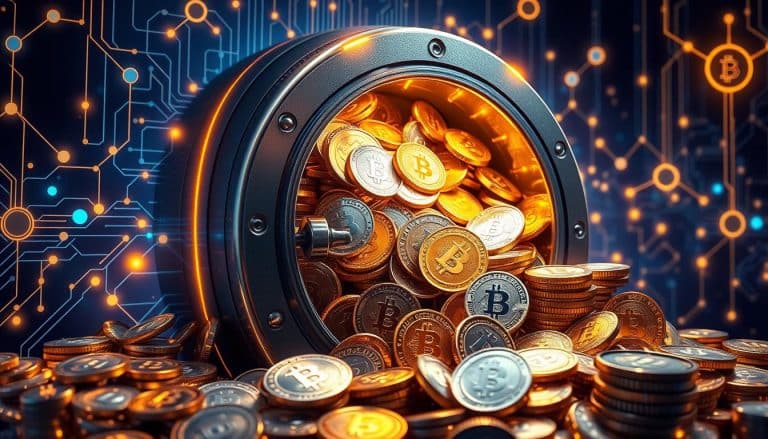Ripple Settlement: What You Need to Know
Ripple Labs, Inc. had to deal with a huge issue. They broke laws by not following rules for 1,278 contracts. This led to a big fine of $125,035,150.00. But what’s really interesting is how the final fine was much smaller than the $2 billion the SEC first wanted1. This story is a key chapter in how digital money and rules from bodies like the SEC clash.
The SEC claimed Ripple got over $1.3 billion wrongly in 2013 by offering XRP without the right permissions2. The court decided XRP isn’t a security for regular buyers on exchanges. However, some deals with big investors did break the rules, according to the Howey Test3. This decision is a major point for the rules around digital currency.
Key Takeaways
- Ripple Labs entered into 1,278 contracts violating securities laws1.
- Ripple was ordered to pay a $125,035,150.00 civil penalty1.
- Ripple raised over $1.3 billion through an unregistered security offering in 20132.
- The SEC lawsuit initially argued for a $2 billion fine, rendered much less than the final penalty1.
- XRP is not a security when sold on exchanges to retail investors3.
Introduction to Ripple and XRP
Ripple and its digital currency, XRP, have changed the world of digital assets and payment systems. They use advanced blockchain technology to make transactions faster and safer. This has made Ripple a big name in the financial industry.
What is Ripple?
Ripple started in 2012 by Chris Larsen and others. It makes cross-border payments quick and cheap through its payment network4. The company has raised $293.8 million, showing investors believe in it4. Big banks like Santander use Ripple, proving it’s widely accepted5.
Understanding XRP
XRP was made with 100 billion units from the start6. Ripple saved 55 billion XRP to ensure the market remains stable6. XRP stands out because it processes transactions very fast, in about four to five seconds. This is a big improvement over systems like Bitcoin5. Plus, sending XRP costs almost nothing, about 0.00001 XRP6
Importance in Digital Assets
Ripple’s XRP is not just for paying. Its usage in the Ripple Ledger shows its flexibility and future potential to lower fees6. XRP could last for a very long time, making it a sustainable choice6. Ripple also offers xCurrent and xVia, which work without XRP, showing Ripple’s broad capabilities6. Courts have said XRP isn’t an investment contract, which confirms its value4.
Ripple’s XRP is key in the advancement of blockchain and changing payment systems across the globe. It highlights its importance in transforming how we do financial transactions.
The SEC’s Complaint Against Ripple
The SEC’s legal action against Ripple has grabbed attention in the crypto world. It claims that Ripple sold XRP as unregistered securities, which should be seen as investment contracts7. This has sparked a lot of talk about how we should view digital currencies under current laws meant for traditional finance.
Details of the Allegations
The SEC says Ripple and its top executives broke the law by selling XRP without official permission7. Ripple disagrees, saying XRP is a currency, not a security. This clash points out the challenge of fitting new tech into old regulations.
Impact on Financial Institutions
The SEC’s case affects more than just Ripple. It makes banks and others wary about dealing with cryptos8. Because Ripple is scrutinized for selling unregistered securities, others are thinking twice about using digital money7. This caution has led many to rethink how they interact with blockchain tech.
Significance of Judge Analisa Torres’ Ruling
Judge Analisa Torres’ decision is very important for cryptocurrency and digital asset rules. It affects Ripple and also shows how digital assets are viewed by the law.
Implications for Cryptocurrency Transactions
Judge Torres made it clear that some Ripple sales to big investors were “securities,” but not others9. This is key because it shows how different cryptocurrency deals should be handled legally. On October 3, 2025, she rejected the SEC’s request to appeal the decision right away, making her view more solid9.
Also, the SEC couldn’t prove Ripple’s leaders did anything wrong regarding the Securities Act9. This outcome could affect future legal cases and shape rules for other digital assets.
Ripple’s Position on the Ruling
Ripple’s team is happy with Judge Torres’ decision because it means XRP is not seen as a security in some situations. This is a big victory for them, protecting them from big damages in court. Even with legal hurdles, Ripple’s worth is still estimated at $11 billion10.
They say this decision brings needed clarity to digital asset rules. It might help guide other cryptocurrency deals by setting clear rules9. But, there are still different opinions in court, like Judge Jed Rakoff’s in another case against Terraform Labs10. Ripple hopes for more consistent rules, but for now, their case is an important guide for the crypto world.
| Date | Event | Impact |
|---|---|---|
| Oct. 3, 2025 | Denial of SEC’s interlocutory appeal | Reinforced summary judgment rulings |
| Oct. 19, 2025 | Dismissal of claims against Ripple’s executives | Reduced potential liabilities for Ripple |
| Oct. 15, 2025 | Ruling on institutional sales as securities | Clarified classification of XRP transactions |
Penalty and Financial Implications for Ripple
Ripple Labs asked for a delay to avoid immediately paying a $125 million penalty decided by the court. This is while they wait for a decision on if XRP counts as a security11. Even though they have to pay $125 million, it’s a lot less than the first $2 billion fine the SEC wanted. Ripple has enough money to cover this fine without too much trouble.
Before September 6, the due date, Ripple wants the New York court to approve their request for delay11. If approved, Ripple wouldn’t have to pay interest until 30 days after the appeal ends11. The $125 million will be kept safe until possibly given back to Ripple, unless the SEC appeals11. Some experts think the SEC might fight back. But, Ripple’s clear way of handling things is attracting attention.
Ripple’s settlement requires them to pay $700,000, with $450,000 for specific charges12. They must also carry out checks to follow rules up through 202012. Ripple faces extra checks due to past issues with their financial monitoring12.
The fines and agreements mark a big moment for Ripple but don’t risk bankrupting them. They’ll clearly show these amounts on their financial records. This shows Ripple is serious about following the law and being transparent. It highlights their ability to navigate challenges in the fast-moving world of digital money.
The Injunction Against Ripple
The District Court has placed a lasting ban on Ripple. This ban limits Ripple’s freedom to sell securities. It shows the court’s determination to enforce securities laws. This means no selling of securities without proper registration.
Details of the Injunction
The court specifically banned Ripple from breaking Section 5 of the Securities Act. This involves selling XRP tokens without registration. The court’s ruling is a strong reminder. Ripple must follow securities laws closely to avoid more legal trouble13.
Judge Analisa Torres fined Ripple $125,035,150. The SEC accused Ripple of selling securities without registration14. This fine was less than what the SEC originally wanted. It shows the court’s fairness without being overly harsh13
Additionally, Ripple received a “bad actor disqualification” for five years. This disqualification prevents certain sales exemptions. It’s a solid plan to keep Ripple in line with securities laws15. The court reviewed Ripple’s 1,278 institutional sales. It found them against Section 5 of the Securities Act13.
The court refused to let Ripple off easy for future exemptions. This sets a tough example for rules in the cryptocurrency world. It’s a warning for all digital currency companies to strictly follow federal laws15.
In conclusion, the court’s decision aims at a clear and lawful digital currency market. Ripple must now always act within securities laws. This decision is about more than a penalty. It’s about ensuring Ripple operates correctly in the long run14.
Ripple’s Response to the Court Order
Ripple has reacted to the court’s decision with a mix of relief and resolve. They are eager to meet the regulatory demands quickly. Ripple’s top lawyer, Stuart Alderoty, has voiced their strong position, focusing on following the rules.
Statements from Ripple’s Executives
Ripple’s big boss, Brad Garlinghouse, is hopeful to solve the case soon, within the first half of 2025. This confidence is boosted by 16 supportive amicus curiae briefs, including one noteworthy from Coinbase16. Their Chief Legal Officer points out the SEC’s recent losses in court, backing Ripple’s strong legal footing16.
They also recognized the hurdles thrown by recent court demands for thorough submissions. Ripple has tackled these by showcasing their On-Demand Liquidity sales as lawful, despite the SEC’s accusations after December 202017.
The united front presented by Ripple’s leaders shines a light on their dedication to follow the law. Their tactical legal strategy is set to enhance their standing in the market while sticking to the latest legal standards.
SEC’s Perspective and Future Actions
The Ripple case ruling has sparked talks about cryptocurrency rules and what it means for the SEC. The court fined Ripple $125,035,150 for selling securities without registering18. Initially, the SEC wanted over $1.95 billion from Ripple, but the smaller fine shows the challenge of applying current rules to digital currencies18.
Possible Appeal by the SEC
The SEC has 60 days to possibly appeal the decision. This time is key as the outcome could influence future rules. If the SEC appeals, it could slow down clarity in regulation as the court looks closely at the case details. The Ripple case also shows the need for clearer rules, as Ripple spent over $200 million on the lawsuit, highlighting the big risks for crypto firms in legal battles19
SEC’s Stance on Cryptocurrency Regulation
SEC Chairman Gary Gensler is tough on cryptocurrency, which slows down the sector’s growth19. In the Ripple case, the court decided that XRP’s sales were securities transactions in some cases but not in others, showing the complicated nature of these regulations20. The SEC focusing on big, known cases and not on charges against individuals shows their strategic approach18. Clear rules are needed to help enforce laws and support innovation in the industry. The judgment shows how future SEC actions could affect companies like Coinbase and Binance, who are watching closely for any helpful changes19.
Here’s a quick look at the financial side of the SEC and Ripple case:
| Aspect | Initial SEC Demand | Final Settlement |
|---|---|---|
| Monetary Sanctions | $1.95 billion | $125,035,150 |
| Ripple’s Legal Expenditure | N/A | $200 million |
The settlement shows a big drop from the SEC’s initial demands. This shift might shape how the SEC handles future digital asset cases.
Impact on Blockchain Technology
The recent Ripple settlement highlights major effects in the blockchain sector. It shows the need for clear token issuance guidance. This helps tell securities and digital assets apart.
Guidance for Future Token Issuers
This case is a milestone for those issuing tokens in the future. It sheds light on what the U.S. sees as a security. Blockchain is cutting costs by up to 25% in banking21.
It’s also expected to boost SME financing by 25%21. These facts underline blockchain’s increasing role in finance. The Ripple case gives crucial guidance for legal token issuance.
Changes in Regulatory Landscape
The Ripple case hints at regulatory changes ahead. Billions are pouring into U.S. blockchain tech22. Regulators are advised to take a careful approach. This lawsuit, amidst economic and social stress from the pandemic, deepens our understanding of digital asset regulation changes22.
Big data is enhancing banking customer analytics by 30% and innovation by 14%21. It’s pivotal for insightful decisions.
This situation is more than a simple policy choice22. It’s about fostering growth while protecting consumers. Thus, applying complexity theory to blockchain is vital. This ensures a balance of stability and innovation in digital asset regulation changes.
| Statistic | Data |
|---|---|
| Cost savings in banking due to blockchain | 25% |
| Increase in SME financing | 25% |
| Customer analytics accuracy improvement | 30% |
| Sustainable innovation performance uplift | 14% |
| Big data quality prediction improvement | 35% |
Ripple’s On-Demand Liquidity Service
Ripple’s On-Demand Liquidity (ODL) service is changing how we make cross-border payments. It allows for instant settlements without needing pre-funded accounts. This cuts down costs while keeping transactions safe. ODL is growing fast, reaching countries like Africa, Argentina, Belgium, Israel, Australia, Brazil, Singapore, the UAE, and the UK23.
What is On-Demand Liquidity?
In 2018, Ripple launched its On-Demand Liquidity service. It addresses issues in small, frequent cross-border payments like high fees and slow transfers. Using cutting-edge Machine Learning, Ripple improves customer experiences and manages funds efficiently23. Many users have moved from RippleNet’s traditional payments to ODL for their international needs23.
Potential Regulatory Issues
Ripple’s ODL service might face regulatory challenges. In July 2025, a judge decided that XRP was considered a security for investors but not on trading platforms. This created confusion about ODL following securities laws24. Ripple’s ongoing legal issues with the SEC and its $2 billion in fines could affect ODL’s future24. The company also uses USDT in the US to sidestep regulation problems, highlighting the difficulties in the legal system24.
It’s crucial to keep up with these issues. Understanding them helps grasp how regulations can influence secure transactions and the use of liquidity services in global payments.
Market Reaction to the Ripple Settlement
The Ripple settlement sparked different reactions in the market. It led to both immediate and long-term effects. The XRP price changed significantly, watched closely by investors.
Short-Term Market Impact
Right after the settlement, the XRP price jumped 27% to $0.64. It showed investors were relieved that the US doesn’t see XRP as a security now25. This rise created a positive vibe among investors, though they remained careful due to the unpredictable nature of the overall crypto market.
The XRP price indicated a potential move towards the $0.5739 resistance level. However, it kept showing downward trends below the 50-day and 200-day EMAs26.
Following these events, XRP’s trading volume outdid Bitcoin’s on several South Korean exchanges. It took over 40% on UpBit and more than 35% on Bithumb and Korbit, showing strong market interest27. In 2025, XRP investment products attracted $21 million, signaling strong investor confidence despite regulatory challenges25.
Long-Term Market Predictions
Crypto market trends hint at a cautiously optimistic future for XRP. Analysts think its price could rise towards the 0.236 Fibonacci line at about $0.97. This means a 50% increase from its current rate25. Yet, they also warn about possible technical corrections27.
The wider crypto market trends still impact XRP’s price. This is due to changes in how investors feel and the regulatory environment. Judge Analisa Torres’ ruling in July 2025 and the ongoing legal matters could steady XRP’s performance. They might lead to a more bullish future26.
Explore XRP’s role in cross-border trade to learn about its changing market dynamics.
Comparisons to Other Crypto Settlements
The world of cryptocurrency settlements varies widely, involving many different parts. Looking at the FTX case study and comparing it with Ripple helps us understand the differences in how they are regulated and the effects of these regulations.
FTX: A Case Study
The FTX case study shows how crypto settlements can be complex and result in big fines. FTX, for instance, faced much larger fines than Ripple. While Ripple Labs was initially asked for a $2 billion settlement by the SEC, Terraform Labs ended up settling for $4.4 billion. This included giving back funds and stopping their operations28.
These cases show how outcomes and penalties can greatly differ. Ripple negotiated their settlement down to $102.6 million. FTX, on the other hand, had tougher consequences because of the different regulatory and business factors they faced28. In comparison to Terraform Labs’ big $4.4 billion settlement, Ripple’s ability to keep running shows they may have had a more favorable stance under CFTC rules28.
Both cases point out how regulatory views and laws like the Howey Test can differ. On July 13, 2025, Judge Torres made a key ruling. She explained that the way XRP was sold didn’t fully meet the Howey Test’s criteria29.
Looking at Ripple and FTX settlements gives us insight into the possible future of CFTC regulations for the crypto world. By studying these examples, we get a clearer view of the subtle differences in legal standards for crypto settlements.
Ripple’s Path Forward
After settling its legal issues, Ripple is planning its next steps in the digital payment world. It now has a clear strategy to stay ahead in the blockchain field. This will help Ripple strengthen its market position.
Ripple’s Future Plans
Ripple wants to use blockchain to make sending money across borders better. With legal challenges mostly over, it’s focusing on new ideas and growing its network. The court lowered the SEC’s demand from $2 billion to $125 million. This lets Ripple grow stronger303132.
Ripple’s CEO, Brad Garlinghouse, sees this as a win for the whole blockchain world. He believes clear rules are crucial for innovation32.
Industry Implications
The future of digital payments is bright with Ripple’s progress. The court’s decision shows how important clear rules are. This will help the blockchain industry grow. Ripple’s strategy shows the benefits of blockchain, like faster transactions and lower costs32.
This settlement is a turning point for Ripple and blockchain. By solving regulatory issues and aiming for growth, Ripple will greatly impact blockchain trends. The move towards blockchain shows the importance of evolving these technologies.
Legal Opinions on the Settlement
The legal fight between Ripple and the SEC has many legal experts talking. They say the Ripple case is very important for the future of cryptocurrency law.
Views from Legal Experts
Legal experts have different thoughts on the Ripple settlement. Some think it’s a big win for Ripple and the crypto world. It could set a good example for other digital currencies. Judge Analisa Torres said that selling XRP through programs doesn’t meet the Howey Test’s third part33. This could protect other cryptocurrencies from being called securities because of how they are sold.
Ripple spent about $200 million fighting the SEC34. But, experts think the SEC might not challenge the ruling on XRP. They say there’s a risk of making things worse by bringing it to a higher court34. This highlights the need for clearer cryptocurrency laws.
Industry Commentary
The discussions in the industry focus on Ripple’s smart legal moves. The SEC wanted a $2 billion fine in March. Ripple offered $10 million, showing a huge difference in case value33. The SEC’s lowest fine was over $100 million33, showing they want big fines for what they see as wrong.
Ripple’s win in court dismissed most claims against it, leaving one small claim worth $174 for trial10. This tiny claim, compared to Ripple’s $11 billion value, shows the industry can handle such issues with ease10. Experts think this points to a trend towards settling before trial in similar future cases.
| Event | Statistics | Reference |
|---|---|---|
| Ripple’s Legal Expenses | $200 million | 34 |
| SEC’s Proposed Penalty | $2 billion | 3334 |
| Calculated Penalty Floor | $102.6 million | 33 |
| Ripple’s Worth | $11 billion | 10 |
| State Law Claim Value | $174 | 10 |
Conclusion
After the Ripple settlement, digital assets and their rules are changing big time. Courts see XRP as a security for big players but not for everyday investors. This view is key as new rules come into play2.
The SEC is working hard to make the crypto world more transparent35. Ripple spent over $150 million to defend itself, showing the huge costs of these legal fights35.
The trial ahead will address serious claims against Ripple’s leaders. But, individual charges against Ripple bosses Brad Garlinghouse and Christian Larsen were dropped. This might guide how personal faults are judged in similar situations2. This case will shape how we see and regulate digital assets moving forward.
To wrap it up, the Ripple case marks a big change at the crossroads of old securities law and new digital currencies. The effects on future crypto rules and how courts view blockchain tokens are big. As the legal drama continues, it’s a major guide for players and rule-makers in the crypto world.








 Bitcoin
Bitcoin  Ethereum
Ethereum  Tether
Tether  XRP
XRP  USDC
USDC  TRON
TRON  Lido Staked Ether
Lido Staked Ether  Dogecoin
Dogecoin  Figure Heloc
Figure Heloc  Cardano
Cardano  Wrapped stETH
Wrapped stETH  WhiteBIT Coin
WhiteBIT Coin  Wrapped Bitcoin
Wrapped Bitcoin  Bitcoin Cash
Bitcoin Cash  Wrapped eETH
Wrapped eETH  Monero
Monero  USDS
USDS  Chainlink
Chainlink  Binance Bridged USDT (BNB Smart Chain)
Binance Bridged USDT (BNB Smart Chain)  LEO Token
LEO Token  WETH
WETH  Stellar
Stellar  Coinbase Wrapped BTC
Coinbase Wrapped BTC  Sui
Sui  Zcash
Zcash  Ethena USDe
Ethena USDe  Hyperliquid
Hyperliquid  Avalanche
Avalanche  Litecoin
Litecoin  Hedera
Hedera  Shiba Inu
Shiba Inu  USDT0
USDT0  World Liberty Financial
World Liberty Financial  Canton
Canton  Dai
Dai  sUSDS
sUSDS  Toncoin
Toncoin  Cronos
Cronos  Ethena Staked USDe
Ethena Staked USDe  PayPal USD
PayPal USD  Polkadot
Polkadot  USD1
USD1  Uniswap
Uniswap  Rain
Rain  Mantle
Mantle  MemeCore
MemeCore  Bitget Token
Bitget Token  Aave
Aave